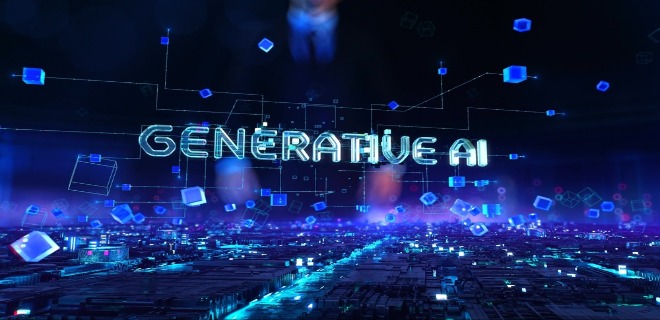
Generative AI is poised to revolutionize the advertising industry, potentially reshaping ad services, customer engagement, and user experience.
When generative AI tools like DALL-E, Midjourney, and ChatGPT-4 hit the mainstream, the tech wowed millions of users with the realism of their results and ease of use. The question of the hour: Will generative AI render human creativity, information curation, and customer support obsolete?
But in advertising and other industries, professionals have anticipated this moment for years. Their questions have been about when it would come and how to navigate the possible outcomes of its implementation. AI-powered search stands to shake up the $500 billion digital ad market, including Google’s $162 billion search advertising business.
But there’s a lot at stake for users, too. Generative AI innovations promise enhanced efficiency and improved customer service, but there’s a growing concern that the race to implement them could lead to further deterioration in service quality. That would only exacerbate existing challenges brands, agencies, and buyers face.
There are risks in implementing this technology too early or too extensively. There are questions about whether AI, as it currently stands, can provide quality service to real people, including in developing ad creative and messaging that resonates with the right audiences.
You Can’t Automate Truth and Accuracy… Yet
Big Tech businesses increasingly rely on generative AI, AI assistants, and chatbots for customer service. AI chatbots commonly provide answers faster than traditional search. But that efficiency and those succinct responses come at the expense of the variety of options and voices users find in traditional search and at the expense of a human sense of empathy.
It’s easy to imagine AI chatbots giving users information pulled from controversial sites that many agencies and campaigns wouldn’t consider brand-safe – which, upon close inspection, may already be happening – and inadvertently spreading misinformation and poor advice or even enabling discrimination. If AI search tools gave users more options to verify results, it could mitigate harm and undermine those tools’ efficiency. Overall, AI could improve user experience by better replicating the human element of service and support – getting to the essential root of a challenge and recommending the best solution. These elements are noticeably lacking with current AI tools, even at the highest tier.
We will unlikely see the broad pause in generative AI development that some tech industry leaders have called for. Brands and agencies are looking into use cases for AI automation, from personalized ad creative to identifying keywords and target audiences to suggesting business decisions. For a rapidly growing business, AI has the potential to relieve the increasing strain on customer support teams and to streamline otherwise manual tasks.
However, brands must monetize the development of these tools. That’s why companies are eyeing AI search results as a vehicle for inserting ads or implementing SaaS models to monetize their chatbots. But those strategies raise another concern about degrading the user experience: the possibility that AI chat tools will produce results that disproportionately favor their advertisers or business partners.
Furthermore, AI reflects human biases in the content it processes, which could disadvantage and harm individuals or entire communities. And with creative personalization, brands, and agencies will need AI tools to deliver on the challenges around standardization of creative audits across ad platforms.
What Users Want Vs. What Users Need
Consumers’ interest in and use of AI chatbots is bound to increase, and brands and agencies will need to respond by weighing their share of and position in the marketplace against their consumers’ user experience. They’ll be calculating how to balance the value of convenience’s broad appeal with their commitment to keeping their consumers safe from misinformation and bias, which can easily erode consumer trust and long-term brand loyalty. They’ll also need to consistently monitor and respond to the maturity level of generative AI.
At the moment, generative AI chat is in a similar place as the metaverse was last year: Industry leaders believe it will change everything – just not with this current generation of technology. This wave of new tech may not accomplish what marketers and other stakeholder teams need right now. Marketers must underline where generative AI isn’t meeting their needs and what future generations of development should deliver to meet those expectations and their campaign or business goals.
AI and Human Experience Both Add Value
There’s an increasing focus on how AI chat can assist teams rather than replace them. While AI can automate many customer service tasks, cutting costs while allowing for greater scale, cross-channel conversations, and personalized responses, live agents often can solve complex problems more quickly than automation. In marketing, the human touch can be seen as a value add, discouraging clients from trying to lowball them.
Currently, generative AI works best for businesses’ internal usage – tasks ranging from media buying and planning to content marketing and messaging to design and basic copy – then for various public-facing uses. For the digital ad industry, AI is a powerful tool against ad fraud: it can efficiently detect activity resembling a fraud scheme and block those likely fraudsters from an ad platform or alert human teams. Remember that fraudsters are also using AI to evade detection, and legitimate businesses will need cutting-edge AI tools to beat fraudsters at their own game – a significant technological lift.
One interesting side effect of this interest in generative AI is that it’s brought about a newfound appreciation of human talent and comprehension. We see the uncanny valley effect of AI-generated text and images, identify what’s not quite there, and know the human touch’s importance in getting us all the way there. These trends have instigated a shift in focus toward the significance of creative elements of marketing.